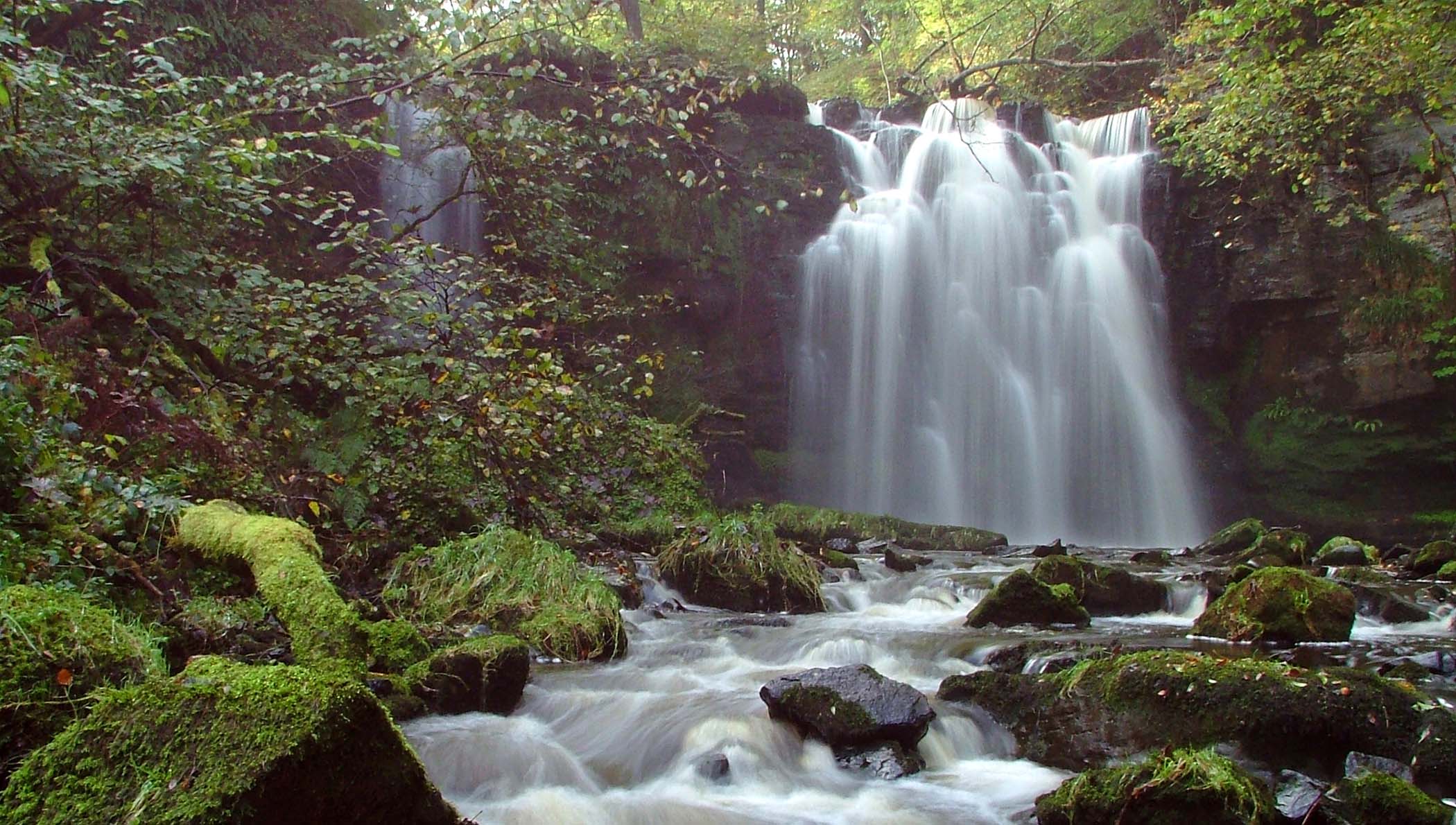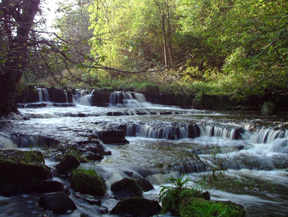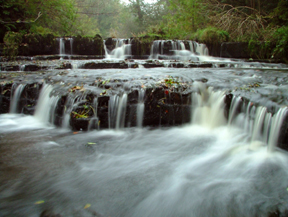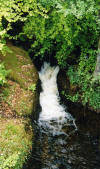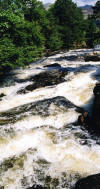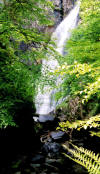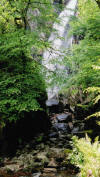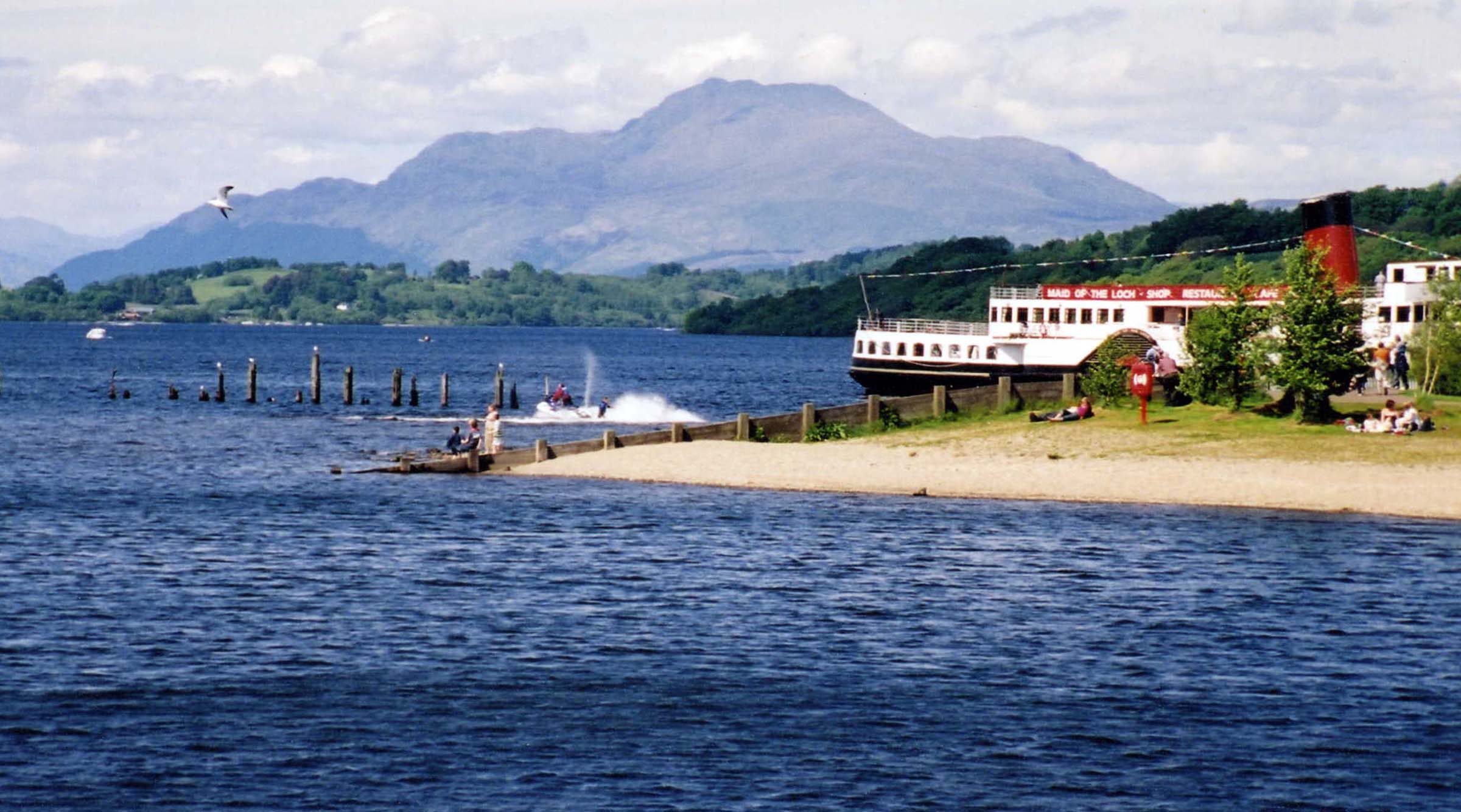|
Loch Lomond After a day of rest at the charming Kirkton House, we ventured to the beautiful Argyll loch of legend and song. It was a day of dark skies, but even that lent a certain majesty to the look of Ben Lomond. Ben is the Scots word for mountain, and a loch is not a lake but a bay or arm of the sea that is nearly landlocked. Lomond is the only loch entirely cut off from the sea.
The River Clyde
Ailsa Craig
"Hearken, thou craggy ocean-pyramid! How
long is't since the Mighty Power bid
Alexander Linn, martyr. It was May when we visited, driest month of the year. How lovely it must look after the rains.
The River Cree and Stravaiger's Rest Described in song as "the silv'ry winding Cree," this river flows south from Ayrshire into Dumfries and Galloway to Wigtown Bay. It takes many turns and has many looks, all of them beautiful. A stravaiger is a wanderer; but can be either one who roams without purpose or direction or one who travels purposefully but unhindered through a wide area. This modern stone, set by the River Cree, is dedicated to travelers past and present, wishing well to all who pass by, whether attending to mundane affairs or pursuing great adventures.
The River Nith and Robert Burns Center
The River Nith rises and falls with the Solway tide and flows through the town of Dumfries, about forty miles east of the Cree. Dumfries was Burns's home later in his too brief life. He is buried several blocks from the river at St. Michael's Kirk, pictured on the "Kirks and Kirkyards" page. The road from St. Michael's Bridge, going into town, will take you directly to the kirk. The two plaques on the side of the bridge bear the arms of Dumfries and Maxwelltown.
The Forth River Lin's Mill Aquaduct on the Almond River - A boat ride on the canal at Lin's Mill would have been pleasant, but we were searching for an ancient property of that name situated on the Almond River in Midlothian. There, we hoped to find the grave of William Lin, "Richt Heritor of Lins Miln," who signed the 1643 Solemn League and Covenant and died of the plague in 1645. We found the mill but not the grave, but had the good fortune years later to hear from someone who shared his photos.
The Other Almond - This Almond River is in Perthshire and is a tributary of the River Tay. The trees on the bank are what caught the eye, but the fishing is said to be good.
Loch Ness Far up into the north lies the "great loch", described by one traveler as "an endless streak of grey." Ness is the largest of three lochs in the Great Glen of Urquhart, stretching 60 miles in a nearly straight line. However, the person who described it so demeaningly must never have seen it when the sun shone, nor visited the spots where its shoreline is most charming. One attractive scene is on the page "Flowers of Scotland". More are on the page "Castles".
The Dochart The River Dochart flows through the village of Killin in Stirlingshire at the western end of Loch Tay and forms numerous falls, pools, and eddies. It is possible to walk out a certain distance on the rocks, but care should be taken. At one point, the falls cascade on both sides of the island of Innes Buie or Inchbuie, traditional burial place of Clan McNab. We were blessed to have a day of beautiful weather on which to enjoy the Dochart. In fact, the weather was wonderful for practically the entire journey. We recommend that visitors to Scotland plan a trip from mid to late May. It is still a bit cool and often overcast, but May typically is the driest month of the year and yet many things are in bloom.
Skye Waters
A Few More Highland Lochs Loch Cluanie Loch Leven Loch Garry Loch Cluanie - This loch is actually a reservoir created in the 1950s by the building of a dam to generate hydroelectricity. Loch Leven - On the far side of this loch, at the foot of the Mamore Mountains, is nestled the village of Kinlochleven, just a few miles from the site of the infamous massacre of the MacDonalds of Glen Coe. We drove into the village, parked, and walked to the foot of the mountains to see the Grey Mare's Tail. Loch Garry - Loch Garry is the headwaters of the River Garry, which flows through the glen of the same name. In 1539, a royal charter for the glen was granted to Alexander MacDonnell, whose sept of Clan Donald came to be called MacDonnell of Glengarry.
The Grey Mare's Tail Aptly named, this plume of water is at the end of one of the highest falls in Britain. The three young ladies we encountered had taken the scenic route home from school to find us with our camera. They seemed amused that a grown woman, not exactly dressed for hiking, would take off her shoes and stand in a pool of water below a waterfall. The photo they watched John take does look a bit silly, which explains why it isn't here.
On the Bonnie Doon
Forget the Hollywood fluff and nonsense called "Brigadoon." The brig o' Doon is a real bridge in the very real village of Alloway, which was but a hamlet when Robert Burns was born there in 1759. It was old even then, having been built in the 12th century. It spans the river about which Burns wrote in "Ye Banks and Braes O' Bonnie Doon." John and I stood on the bridge and wondered if Burns had often stood on the same spot. We also had the pleasure of staying at a bed and breakfast where the property slopes down to the very banks of the Doon. One evening we sat by its gently flowing waters, singing all the Burns songs we knew. The Bard of Scotland wrote "Auld Lang Syne," "Ae Fond Kiss," "Scots Wha Hae" and hundreds of other romantic, heroic, or humorous songs and poems about his native land and people.
Loch Lomond Farewell "By yon bonnie banks and by yon bonnie braes, where the sun shines bright on Loch Lomond !"
the balcony. Wistfully, I gazed out over the blue waters and thought of that beautiful but melancholy song I'd heard since childhood. Legend has it that the Scottish song "Loch Lomond" was written by a Jacobite soldier from Argyll who was captured and left behind in England after the rising of 1745. He was to be executed, while his comrades were to be released. According to Gaelic folklore, the spirits of the dead travel by the "low road" and the condemned man would arrive in Scotland while the living continued to struggle over the earthly terrain of the "high road." And so, the soldier who would be executed wrote to one of his comrades of the sweetheart he would never meet again, and the lovely loch they had so often and so well enjoyed ... By yon bonnie banks and by yon bonnie braes, Where the sun shines bright on Loch Lomond,
Where me an' my true love were ever wont to gae
~ 'Twas there that we parted in yon shady glen On the steep, steep sides o' Ben Lomond, Where in the purple hue, the Hieland hills we view, An' the moon comin' out in the gloamin'. Oh, ye'll tak the high road an' I'll tak the low road, And I'll be in Scotland afore ye, But me an' my true love will never meet again On the bonnie, bonnie banks o' Loch Lomond. (Author Unknown) Our own parting at Loch Lomond was not from each other but from the land we had come to love so well on a journey that had begun only two weeks before. How swiftly the days had flown! Along the way, we had encountered creatures great and small. We had visited kirks and castles, lovely gardens, and inspiring tombs. We surveyed battlefields and monuments, sky-blue lochs, and picturesque bridges. We gazed at lofty mountains and shining rivers and seas. We enjoyed charming hospitality and wonderful Scottish cooking. And we discovered our Scottish heritage and our heritage of faith. For most of my life, seeing Scotland had been my heart’s desire, while John once would have been happy never to leave American soil. Then, a few years ago, we went to the Grandfather Mountain Highland Games in North Carolina, and John began to think that a visit to Scotland just might be fun. Still, the trip was my dream, and he was willing to go anywhere I wanted, no matter how remote, and in spite of having to drive on the "wrong" side of the road, from the "wrong" side of the car. It was sometimes a daunting task. Imagine my surprise then, on the plane leaving Glasgow to come home again, when he smiled at me and declared, “We are coming back to Scotland!” Then I thought, having seen and done all I had dreamed, that my journey of a lifetime could not have been more perfect.
For we're no awa' tae bide awa',
Copyright 2018 · Loretta Lynn Layman · The House of Lynn
| ||||||||||||||||||||||||||||||||||||||||||||||||

.jpg)




